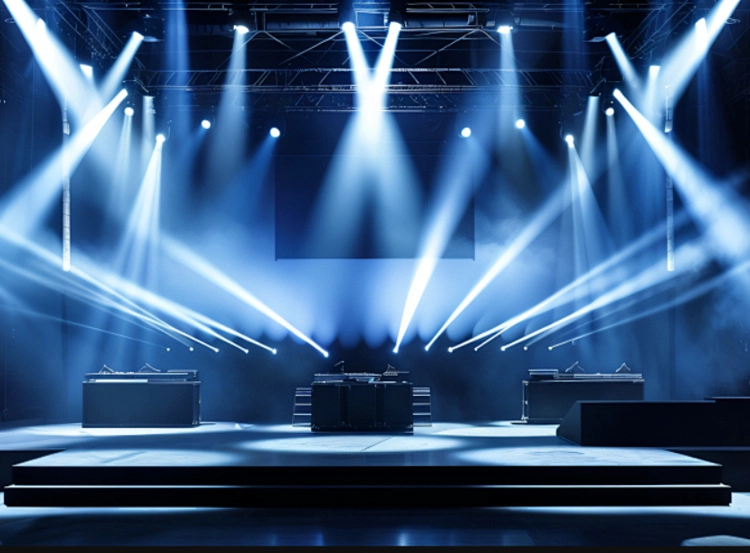1. How Stage Lighting Fixtures Work
Stage lighting fixtures are like “magical lights” — their structure and functions are much more complex than ordinary household lamps.Main components include:
- Light Source: Includes traditional halogen bulbs, metal halide lamps, and modern LEDs. LEDs are now mainstream due to their energy efficiency, long lifespan, and color-changing capabilities.
- Reflector: Located behind the light source, it reflects and concentrates scattered light, increasing brightness and efficiency.
- Lens/Optical System: Adjusts the width and throw of the light beam. Profile lights (ellipsoidals) can create sharp edges and even project patterns.
- Cooling System: High-power fixtures generate a lot of heat, so they usually have fans or heat sinks to ensure safe, stable operation.
- Accessories:
- Color Gels/Wheels: Change the color of the light by swapping or rotating color filters.
- Barndoors: Control the shape and coverage of the beam, preventing light spill.
- Gobo: Metal or glass discs that project patterns like tree shadows or stars.
Common Fixture Types:
- Floodlight: Provides broad, even illumination, ideal for backgrounds or general washes.
- Profile/ERS (Ellipsoidal): Produces sharp beams, can use gobos for pattern projection, perfect for highlighting main characters.
- Fresnel: Soft-edged beam, great for fill light or edge transitions.
- PAR Can: Simple structure, strong beam, often used for atmosphere and color washes.
- Moving Head: Can remotely control direction, color, pattern, and beam width — the “multi-tool” of modern stages.
2. Programming and Control of Stage Lighting
Modern stage lighting relies on programming and digital control:
- DMX512 Protocol: The international standard for stage lighting control. Each fixture is assigned one or more “channels,” each controlling a parameter (such as brightness, color, pan/tilt, etc.).
- Control Consoles/Software:
- Designers use physical consoles or computer software to program each fixture’s actions.
- “Scenes” can be preset (e.g., Scene A: warm main light; Scene B: blue atmosphere) and switched with one button.
- Supports “timeline programming” to synchronize lighting with music, video, or special effects.
- Intelligent Fixtures: Such as moving heads and LED matrix lights, support remote focus, color change, gobo switching, and even built-in auto programs.
Example Programming Workflow:
- The designer plans the lighting mood for each scene based on the script and music.
- Assigns addresses and channels to each fixture on the console.
- Records each “cue” step by step, including brightness, color, movement, etc.
- Rehearses and fine-tunes each cue’s timing and effect to perfectly match the performance.
3. Real-World Case: Concert Lighting Show
Take a large pop concert as an example, with lighting design details as follows:
- Opening: The whole stage is dark. Before the main performer appears, blue Fresnel lights create a mysterious atmosphere at the stage edges. When the star enters, a profile spotlight instantly highlights them, grabbing the audience’s attention.
- Verse: PAR cans and LED strip lights set the main color tone, moving heads sweep slowly to create a sense of flow.
- Chorus/Climax: Moving heads rapidly change color and direction, combined with fog machines for visible beams. LED matrix lights flash in sync with the music, pushing the atmosphere to a peak.
- Ballad/Slow Song: Lighting becomes soft pink or blue, with wide beams for a warm, dreamy mood. Gobos project starry skies or petals on the background for extra visual effect.
- Interactive Segment: The lighting operator adjusts brightness and color in real time based on the audience’s reaction, enhancing engagement.
- Curtain Call: All lights gradually brighten, the stage becomes warm and welcoming, and the show ends with thunderous applause.
4. Lighting Design and Teamwork
- Collaboration with Director/Set Designer: The lighting designer must work closely with the director, set, and sound teams to ensure the lighting matches the plot, scenery, and costume style.
- Safety and Maintenance: All fixtures must be secured with safety cables, cables routed properly, and equipment regularly checked to ensure safe performances.
- Innovation and Technology: Modern stage lighting can also be combined with lasers, projection, AR, and other new technologies to create even more stunning visual experiences.
Stage lighting is the perfect blend of technology and art. Every beam, every change, is the result of teamwork, wisdom, and hard work.
